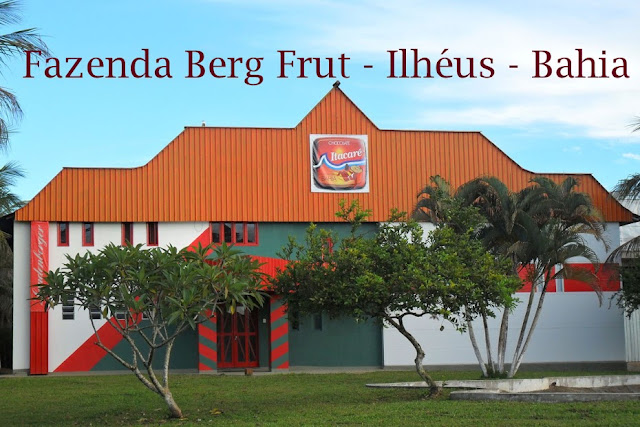 |
| Chocolate Itacaré Factory |
 |
| Coccy's on the table |
After a long and bumpy journey through the thick, green forest, we arrive at a clearing and see a red, green and white painted building, reminding me of something from Hansel and Gretel. We drive through the large gates, around the pond, and park alongside the building.
After entering the large red doors at the front, we notice a display or various different chocolates, wrapped in gold, silver, pink or red foil. Some are designed in the shape of huge Easter eggs, others as football shoes, and some as tiny hearts, all to display what the Chocolate Factory has to offer.
 |
| The cacau in the farm |
We head up the stairs and reach an office with a balcony. I step out onto the balcony and am presented with an amazing view of the farm and rainforest below, with the hundreds of beautiful shades of green from the trees and bushes rolling into the distance, filling my nose with a wonderful hot, tropical smell. Back in the office, there is a small table with a tray of various milk and dark chocolate. We asked to try them and I happily oblige, they taste delicious!
After a brief induction about the factory and its history, I am taken on a walk around the building to see the 'cacau' (cocoa) growing on the trees. I pick one, the guide cuts it open with a knife, and inside the yellow shell is a collection of beans covered in a white gel. I am told to taste the coating, as he hands me one of the small, white covered beans. I pop it dubiously into my mouth. Delicious! The white creamy coating has a slightly sour but sweet taste. The bean however is extremely bitter when I bite into it! It needs to be fermented, dried, and roasted before it is edible.
 |
| The opened cacau fruit |
In the factory, the well organized process is like clockwork. The fruit pickers collect the cacau from the trees and take them to the factory. They are then cut open, where the insides are removed from its shell and put into a separate box. A machine then separates the white cream from the cocoa beans. The cream is then used to make a frozen fruit juice, where the beans are then dried and ground to produce chocolate. Once the chocolate reaches its final stage, the staff then pour the liquid chocolate into various moulds and put them in the fridge. At the time of my visit, it was two weeks before Easter, so the factory was full of people making lots of various sized eggs. At the end of the factory tour, I am taken to a large room where the final products are kept. It was like being in Charlie and the Chocolate’s Factory, wall to wall full of shelves of brightly colored and enticing looking chocolate.
 |
| The roasted cocoa bean before producing cocoa mass |
After my tour, I have a filling, home-made meal in the on-site house, then take a slow walk around the grounds of the farm . I feel very short among the tall, thick trees full of hanging cacau and cupuacu (another local, Brazilian fruit). The rainforest sounds like an orchestra, I stop in my tracks and hear the high pitched noise of thousands of crickets, many different calls of various, colourful birds and the low rumble of the frogs in the distance. I begin to get eaten alive by the mosquitoes, so quickly head back up to the house, just in time to see the sun set over the rainforest, a truly magical sight.
Later on, I am taken to watch a professional marketing video that has been made for the Chocolate Itacaré Factory. I also watch a news report which congratulates Diva and her work colleagues on the success of the company.
The chocolate was incredible, and perhaps tasted even better knowing that it had been made fresh on the site without any added preservatives or E numbers. The produce is delivered to many major cities around Brazil including Rio de Janeiro and São Paulo, as well as locally in Ilhéus.
 |
| Molten Chocolate being moulded |
The journey and day spent at the factory was incredible. It’s great to see that people are making the most of their local resources here in Brazil. Coming from the Britain where 50% of our food is imported, it’s good to see that Brazil uses locally sourced, fresh, organic produce and distribute it to the rest of the country. It is an inspiration for many countries, not just the UK.
Diva, and the staff I met made me feel so welcome, and the things I saw and experienced I will never forget. Chocolate Itacaré should be a stopping point for any tourist visiting the city of Ilhéus.
 |
| Just a small selection of their final products |